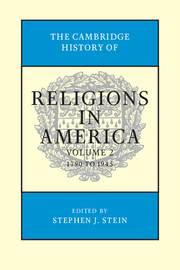Book contents
- Frontmatter
- Contents
- Contributors
- Editor's Introduction
- SECTION I RELIGION IN NORTH AMERICA
- SECTION II RELIGIONS IN THE NEW NATION, 1790–1865
- SECTION III CHANGING RELIGIOUS REALITIES
- 11 Diversity, Revival, Rivalry, and Reform: Protestant Christianity in the United States, 1800–1950
- 12 American Catholics, 1800–1950
- 13 American Judaism, 1820–1945
- 14 Formation and Consolidation of African American Religious Communities, 1865–1945
- 15 Eastern Orthodox Christianity in America
- 16 New Religious Movements
- 17 American Indian Religions in America, 1790–1945
- 18 Why Muslims Matter to American Religious History, 1730–1945
- 19 Asian Religions in the United States: The Role of the 1893 World’s Parliament of Religions in Shaping an Evolving Pluralist Ideology
- 20 Metaphysical Movements
- SECTION IV RELIGIOUS RESPONSES TO MODERN LIFE AND THOUGHT
- SECTION V COMPARATIVE ESSAYS
- SECTION VI RELIGION AND DIVERSE AREAS
- Index
- References
13 - American Judaism, 1820–1945
from SECTION III - CHANGING RELIGIOUS REALITIES
Published online by Cambridge University Press: 28 July 2012
- Frontmatter
- Contents
- Contributors
- Editor's Introduction
- SECTION I RELIGION IN NORTH AMERICA
- SECTION II RELIGIONS IN THE NEW NATION, 1790–1865
- SECTION III CHANGING RELIGIOUS REALITIES
- 11 Diversity, Revival, Rivalry, and Reform: Protestant Christianity in the United States, 1800–1950
- 12 American Catholics, 1800–1950
- 13 American Judaism, 1820–1945
- 14 Formation and Consolidation of African American Religious Communities, 1865–1945
- 15 Eastern Orthodox Christianity in America
- 16 New Religious Movements
- 17 American Indian Religions in America, 1790–1945
- 18 Why Muslims Matter to American Religious History, 1730–1945
- 19 Asian Religions in the United States: The Role of the 1893 World’s Parliament of Religions in Shaping an Evolving Pluralist Ideology
- 20 Metaphysical Movements
- SECTION IV RELIGIOUS RESPONSES TO MODERN LIFE AND THOUGHT
- SECTION V COMPARATIVE ESSAYS
- SECTION VI RELIGION AND DIVERSE AREAS
- Index
- References
Summary
The history of Judaism in America from the 1820s through the end of World War II falls into two unequal time periods. The long century from the 1820s through the middle of the 1920s took its basic shape from the fact that three million European Jews immigrated to the United States. The second, much shorter, from the end of mass migration until 1945, reflected the increasing American nativity of the Jewish people as well as their steady journey into the educated middle classes.
In the 1820s and before, Jews constituted a tiny fraction of the American population, limited in their settlement to a few eastern seaboard cities as well as to a number of emerging inland communities like Cincinnati and Pittsburgh. They maintained a relatively invisible persona and did not seek to impress the American landscape with markers of their presence. They did little to make other Americans aware of their presence, and their religious institutions constituted the dominant forms of Jewish communal life. In most places they maintained only one synagogue, and it constituted the only functioning center of Jewish life, taking care of the Jews' religious, educational, and charitable needs.
By 1945, while Jews still constituted a minority in a predominantly Christian populace, never making up more than 4 or 5 percent of the population, they assumed a prominent place in American society. They drew attention to themselves as Jews.
- Type
- Chapter
- Information
- The Cambridge History of Religions in America , pp. 273 - 299Publisher: Cambridge University PressPrint publication year: 2000

